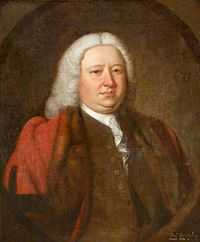Yeotown, Goodleigh
Yeotown was a historic estate situated in the parish of Goodleigh, North Devon, about 1 1/2 miles north-east of the historic centre of Barnstaple. The mansion house was remodelled in about 1807 in the neo-gothic style by Robert Newton Incledon (1761-1846), eldest son of Benjamin Incledon (1730-1796) of Pilton House, Pilton, near Barnstaple, an antiquarian and genealogist and Recorder of the Borough of Barnstaple (1758–1796). It was demolished during his lifetime and today only one of the large gatehouse survives, since converted into a farmhouse known as Ivy Lodge. The surviving drawing of the house in the collection of the North Devon Athaneum in Barnstaple shows a large chapel, or small church, with a tall square three-storied pinnacled tower (presumably as is conventional at the west end) attached to the house.
Location
The mansion house was situated in the sequestered wooded valley of the small River Yeo, about 1 mile south-west of the village of Goodleigh. Near to what Gribble (1830) called "Yeotown Lodge" (now Ivy Lodge) on the road from Goodleigh to Barnstaple is situated the stone marker of the eastern boundary of the parish of Barnstaple.[2]
History
The earliest recorded owners of the estate were the Beavis family
Beavis

- Henry I Beavis was Mayor of Barnstaple in 1738 and 1751, and his portrait survives in Barnstaple Guildhall.[4] The senior line of the family of Beavis had been from the 16th century lords of the manor of Clyst Satchville, Devon. In 1822 Clist House was the seat of Lord Graves, whose father Lord Graves had purchased it from the executors of "Miss Beavis" (d.1801).[5]
- Col. Henry II Beavis, son. On 5 July 1803 he was appointed by the King as Lieutenant-Colonel Commandant (of 441 men) of the Barnstaple Volunteer Infantry[6] (one of several regiments then being raised nationwide to defend against a possible French invasion by Napoleon) and in 1826 was trustee of the Barnstaple charity established by the will of John Phillips (d.1734), whose executor had been the Colonel's father Henry Beavis.[7] In 1810 he was the owner of the large estate of Kentisbury Barton.[8] Col. Beavis had no children of his own and thus adopted a daughter Elizabeth Beavis, who became his sole heiress and the wife of Robert Newton Incledon (1761-1846).
Incledon
- Robert Newton Incledon (1761-1846), eldest son of Benjamin Incledon (1730-1796) of Pilton House, Pilton, near Barnstaple, an antiquarian and genealogist and Recorder of the Borough of Barnstaple (1758–1796). In 1797 married Elizabeth Beavis, the adopted daughter of Col. Henry Beavis of Yeotown. In 1806 Robert sold Pilton House to James Whyte[9] and in 1807 was resident at Yeotown House, the mansion house on his wife's family estate of Yeotown,[10][11] which he "new fronted in the Gothic style"[12] to his own design.[13] Robert purchased from the Rashleigh family the manor of Goodleigh,[14] and thus Yeotown became the manor house of Goodleigh. For reason unknown the mansion was demolished during the lifetime of Robert Newton Incledon (d.1845),[15] who died aged 84 at his residence in Ilfracombe.[16] The large inscribed grave-slab of Robert and his wife Elizabeth Beavis survives in the south aisle of the chancel of Pilton Church. He left two daughters, including Margaret Incledon, the last of the Incledon family, alive in 1890,[17] jointly lords of the manor of Goodleigh in 1850.[18]
Abandonment & demolition
The historian of Barnstaple Joseph Gribble wrote in 1830 concerning the River Yeo: "This stream...forms one of the most prominent objects of attraction from the late splendid but now desolate and forsaken mansion of Yeotown".[19]
Today there survives only one of the large imposing castellated gate house lodges, with two square towers either side of the tall gothic arched entrance way, to which was later added a farmhouse with crenellated gable-end to match with bay-window. It is now a grade II listed building known as Ivy Lodge.[20]
References
- ↑ Fice, J.E., History of Goodleigh, A North Devon Village, Barnstaple, 1982
- ↑ Gribble, p.546
- ↑ Lysons, Magna Britannia, vol.3: Devonshire, London, 1822, Families removed since 1620
- ↑
- ↑ Lysons, Daniel and Samuel Lysons, Magna Britannia: volume 6: Devonshire, 1822
- ↑ London Gazette, 2–5 July 1803, p.788 ; List of Volunteer and Yeomanry Corps of the United Kingdom, Lindon, 1804
- ↑ Report of the Commissioners concerning Charities containing that part which relates to the County of Devon, Vol.1, Exeter, 1826, p.216, Hundred of Braunton
- ↑ Risdon, 1810 Additions, p.432
- ↑ Reed, p.143
- ↑ North Devon Record Office, B187/10, dated 29 September 1807: "Draft conveyance Robert Newton Incledon of Yeotown, parish of Goodleigh, esq., to Edward Dicker of Barnstaple, innholder and his trustees, John Nicholls of Heanton Punchardon, yeoman and John Vellacott of Fremington, gent. Claddovin Park and Great Benham Field, Pilton
- ↑ Risdon, Tristram (d.1640), Survey of Devon, 1811 edition, London, 1811, with 1810 Additions, p.428
- ↑ White's Devonshire Directory of 1850, re Goodleigh
- ↑ Lysons, Magna Britannia, Vol.6: Devon, 1822, re Goodleigh
- ↑ Lysons, Magna Britannia, Vol.6: Devon, 1822, re Goodleigh
- ↑ Fice, J.E., History of Goodleigh, A North Devon Village, Barnstaple, 1982
- ↑ North Devon Journal, 25 December 1845, Obituary, page 3, col.D
- ↑ Vivian, Lt.Col. J.L., (Ed.) The Visitation of the County of Devon: Comprising the Heralds' Visitations of 1531, 1564 & 1620, Exeter, 1895, p.499, pedigree of Incledon
- ↑ White's Devonshire Directory of 1850, re Goodleigh
- ↑ Gribble, Joseph Besly, Memorials of Barnstaple: Being an Attempt to Supply the Want of A History of that Ancient Borough, Barnstaple, 1830, p.555
- ↑ Pevsner, p.458;Listed building text, Ivy Lodge